The ASRock X99E-ITX/ac Review: Up to 36 Threads in Mini-ITX
by Ian Cutress on June 24, 2015 8:00 AM ESTCPU Performance
Readers of our motherboard review section will have noted the trend in modern motherboards to implement a form of MultiCore Enhancement / Acceleration / Turbo (read our report here) on their motherboards. This does several things, including better benchmark results at stock settings (not entirely needed if overclocking is an end-user goal) at the expense of heat and temperature. It also gives in essence an automatic overclock which may be against what the user wants. Our testing methodology is ‘out-of-the-box’, with the latest public BIOS installed and XMP enabled, and thus subject to the whims of this feature. It is ultimately up to the motherboard manufacturer to take this risk – and manufacturers taking risks in the setup is something they do on every product (think C-state settings, USB priority, DPC Latency / monitoring priority, memory subtimings at JEDEC). Processor speed change is part of that risk, and ultimately if no overclocking is planned, some motherboards will affect how fast that shiny new processor goes and can be an important factor in the system build.
For reference, the X99E-ITX/ac has Multicore Turbo disabled by default in BIOS P1.20. The important element to note here is if dual channel memory has an effect in performance.
Point Calculations – 3D Movement Algorithm Test: link
3DPM is a self-penned benchmark, taking basic 3D movement algorithms used in Brownian Motion simulations and testing them for speed. High floating point performance, MHz and IPC wins in the single thread version, whereas the multithread version has to handle the threads and loves more cores. For a brief explanation of the platform agnostic coding behind this benchmark, see my forum post here.

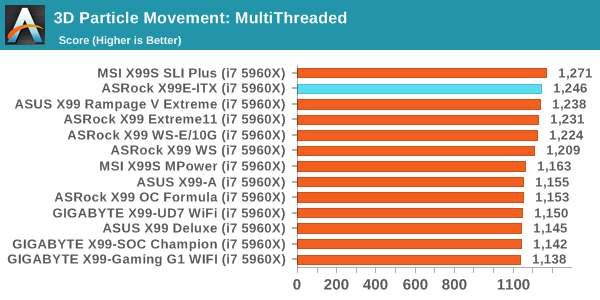
3DPM is not DRAM dependent, so dual channel memory has no issue here.
Compression – WinRAR 5.0.1: link
Our WinRAR test from 2013 is updated to the latest version of WinRAR at the start of 2014. We compress a set of 2867 files across 320 folders totaling 1.52 GB in size – 95% of these files are small typical website files, and the rest (90% of the size) are small 30 second 720p videos.
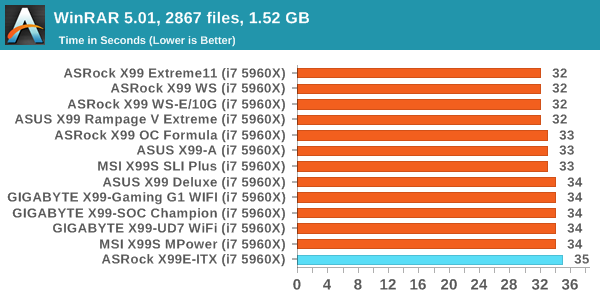
WinRAR is typically a benchmark that tackles DRAM, and we see that the dual channel orientation has a small detriment here.
Image Manipulation – FastStone Image Viewer 4.9: link
Similarly to WinRAR, the FastStone test us updated for 2014 to the latest version. FastStone is the program I use to perform quick or bulk actions on images, such as resizing, adjusting for color and cropping. In our test we take a series of 170 images in various sizes and formats and convert them all into 640x480 .gif files, maintaining the aspect ratio. FastStone does not use multithreading for this test, and thus single threaded performance is often the winner.
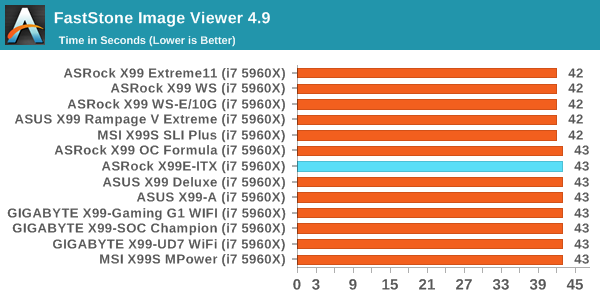
FastStone is a CPU benchmark, so no difference here.
Video Conversion – Handbrake v0.9.9: link
Handbrake is a media conversion tool that was initially designed to help DVD ISOs and Video CDs into more common video formats. The principle today is still the same, primarily as an output for H.264 + AAC/MP3 audio within an MKV container. In our test we use the same videos as in the Xilisoft test, and results are given in frames per second.
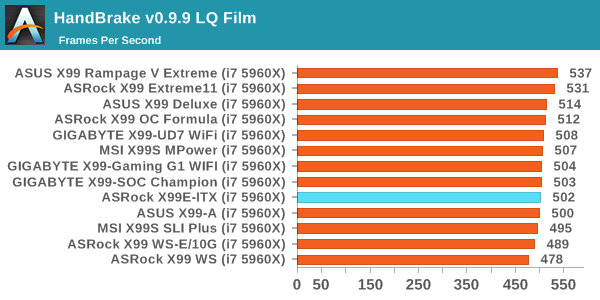
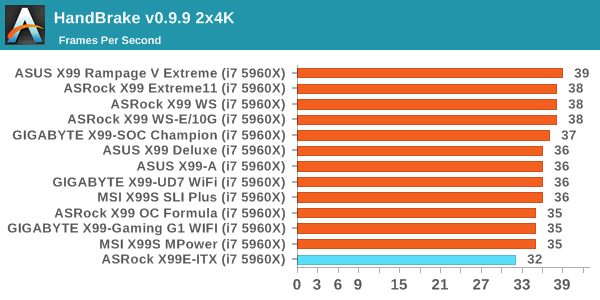
One would normally point at video conversion as requiring DRAM accesses, but we see a difference here between low quality conversion and high quality conversion. Using the larger frames we see that dual channel memory causes a ~10% drop in performance compared to other non-MCE enabled motherboards.
Rendering – PovRay 3.7: link
The Persistence of Vision RayTracer, or PovRay, is a freeware package for as the name suggests, ray tracing. It is a pure renderer, rather than modeling software, but the latest beta version contains a handy benchmark for stressing all processing threads on a platform. We have been using this test in motherboard reviews to test memory stability at various CPU speeds to good effect – if it passes the test, the IMC in the CPU is stable for a given CPU speed. As a CPU test, it runs for approximately 2-3 minutes on high end platforms.
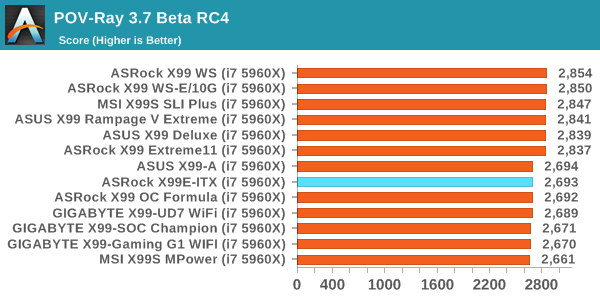
No changes for POV-Ray in dual channel.
Synthetic – 7-Zip 9.2: link
As an open source compression tool, 7-Zip is a popular tool for making sets of files easier to handle and transfer. The software offers up its own benchmark, to which we report the result.
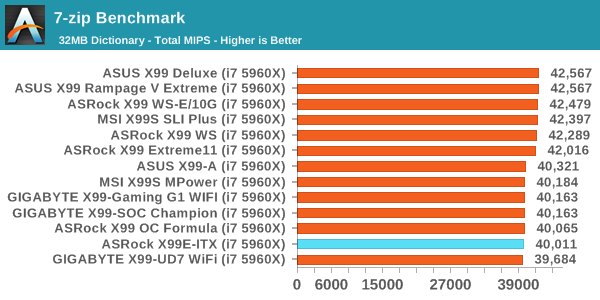
Similarly no difference in 7-zip.










56 Comments
View All Comments
mobutu - Wednesday, June 24, 2015 - link
"For readers expecting the AMD Fury X review, unfortunately Ryan has been battling a virus this week and despite his best efforts it has taken its toll"lol, this was the same reason given for the missing nvidia 960 review, and then it was next week, then next etc and its like half a year late already ...
1mpetuous - Wednesday, June 24, 2015 - link
If you're too desperate to wait for analysis the raw data is already in Bench.der - Wednesday, June 24, 2015 - link
20th comment.MOAR THREADS MOAR POWER!
bernstein - Wednesday, June 24, 2015 - link
while it might be *cool* to have 18 cores in mITX form, $4500 for such a cpu makes it prohibitively expensive for almost all mITX use-cases, heck even 14 cores at $2750 or 10 at $2000 i mostly just wasting money. these are designed & sold for 2S or 4S configurations!its the E5-16xx v3 cpus that make most sense... so were talking up to 8 cores...
bernstein - Wednesday, June 24, 2015 - link
or a i7-5xx0... but then you loose ECC...MrSpadge - Wednesday, June 24, 2015 - link
I think the 5820K would be best suited for this mainboard, as it relaxes cooling and is going to "suffer" the least from dual channel memory.cyrusfox - Wednesday, June 24, 2015 - link
I don't get it, one of the reasons I would get this platform is for quad channel memory, seems like they could have made this work by using sodimms and doing some inventive layout by allowing half the ram to be attached to the back of the board.DanNeely - Wednesday, June 24, 2015 - link
If they used SoDIMMs an equal number of commenters would be flaming it for being limited to crappy lower performing ram. At present availability might be a problem too. Newegg and Amazon don't appear to have any DDR4 SoDIMMs available; and the only capacity Micron lists as being in production is an 8GB version.yuhong - Wednesday, June 24, 2015 - link
I think there is another server oriented mini ITX X99 board that does that, using DDR4 ECC SO-DIMMs I think. Unfortunately they are more expensive at this point.creed3020 - Monday, June 29, 2015 - link
Look no further than the ASRock RACK EPC612D4I for a mITX board with LGA2011-3 and quad channel memory support.http://www.servethehome.com/asrock-rack-epc612d4i-...